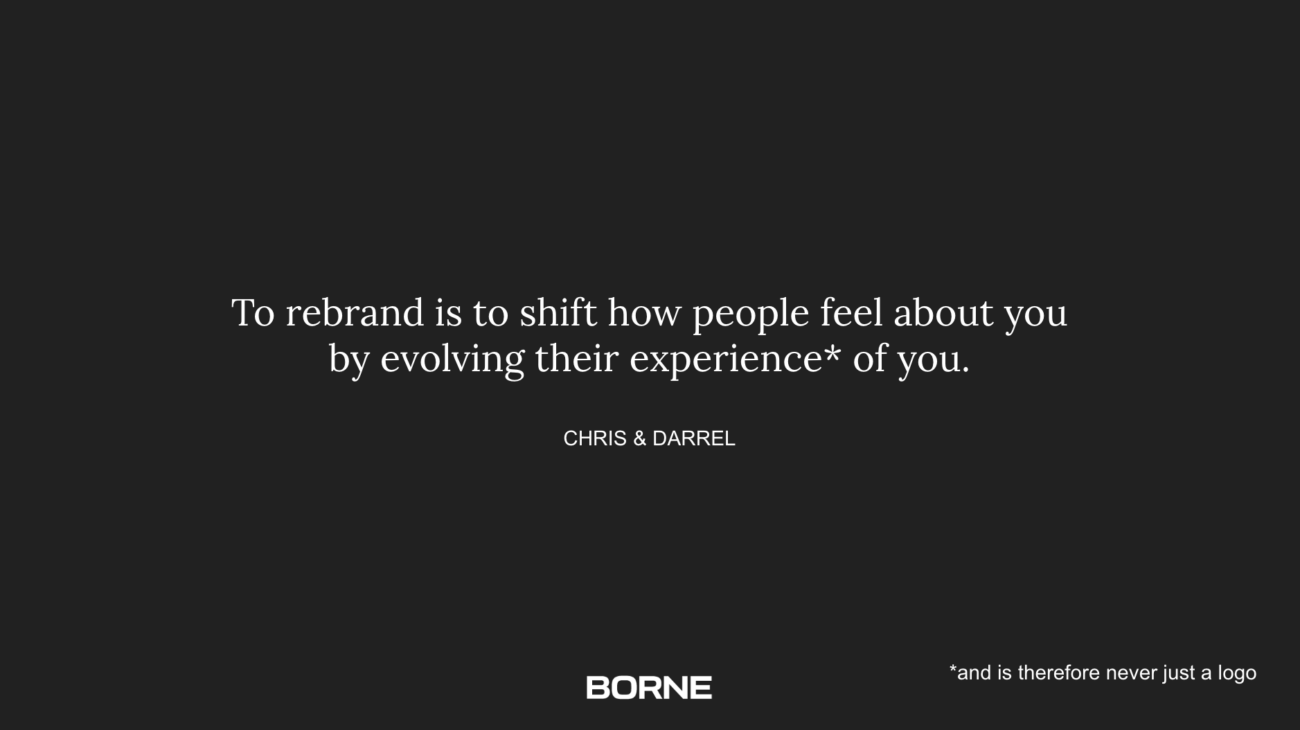What are some of the essential considerations before rebranding a business? Borne creative heads have some suggestions.

Why, when and how should you rebrand? It’s a subject that Borne’s Head of Strategy Chris Bosher and Head of Creative and Design Darrel Williams brought to life at a recent Norfolk Network event. Here are six key takeaways from the discussion.
Rebranding can achieve a number of aims
There are a number of push factors for rebranding a business, but number one is that something has changed. “There could be a commercial or cultural imperative to change,” Chris explains, “and a rebrand can help an organisation carry itself into a new category or galvanise people internally.”
Classic reasons for rebranding are to connect with a new audience or to impact price elasticity: I will pay more for a brand than I would for a generic. “It’s essentially why brands exist,” Chris says. “History is littered with people rebranding to either add value or to justify premium within a context.
“Alternatively, you might think about rebranding to reinvent or run away. Broadly, I’d advocate not being the kind of company that creates scandals. But the next time you see a major rebrand, it’s worth appraising that maybe one of the reasons they’ve done that is because they don’t want association with where they’ve been.”
Consensus is crucial
The positioning strategy enables you to articulate what the experience of the brand, product, service or organisation needs to be in order to solve the problem. But ahead of any design work, you need to get consensus, advises Chris.
“Once you have some evidence of why the strategy is the right one for the brand, get consensus from your stakeholders, because then you have a completely objective frame for appraising any creative work.
“It also means that you can get input on the strategy or narrative and everything else that you’re using to represent the intent for that brand before you’ve committed any creative time to development. Consensus is something you can look for throughout a process but I think it’s really important at that point.”
Understand the value of brand equity
When you’re planning a rebrand, you want to be sure you achieve a degree of differentiation in the minds of the audience and have distinctive brand assets to make sure the brand is visible.
You also have to ensure that you don’t throw the baby out with the bath water.
Failing to understand the equity of a brand can have a devastating effect. Darrel offers the infamous Tropicana rebrand of 2009 by way of example: “They decided they needed to be a little more modern, a little bit more accessible and they completely changed the logo and typography.
“They saw an almost 20 percent drop in sales volume and a $33 million loss of sales value in eight weeks. Their core consumer couldn’t see Tropicana in the supermarket fridges and ended up picking up a competitor. So they just changed it back and their sales went up again.”
It’s an extraordinary case study in not understanding your key brand assets, Chris adds: “It’s important to be very clear about what carries equity, particularly if you are considering a significant rebrand. If possible, use some budget to understand that.”

The decision to rebrand is not always determined by you
A wave of change within a market can force a refresh upon an organisation. “It is entirely dependent on category or competitive set,” Chris says, “but sometimes it’s simply not up to you whether you need to rebrand, it’s the external environment that will determine whether or not you do so.”
“If, say, you are a traditional British shoemaker, then arguably it’s important that your brand doesn’t change very often because that’s the basis of the drivers of value in your category. But for most brands and most organisations in most contexts, things change quite quickly all the time. A marketing dynamic or a commercial dynamic around your organisation will dictate that it’s probably time to evolve.”
Be absolutely clear what the objective of a rebrand is
Nobody likes change, so there needs to be a good reason for introducing it. “An organisation will have multiple objectives for a rebrand, but they’ll always be a primary focus,” highlights Darrel. “It’s really important to start with this objective otherwise you can’t evaluate it later.”
The objective will determine who you need to go and talk to and what you need to learn. “The listening and learning stage could involve research and six months of focus groups in 15 markets, but sometimes it’s as simple as having really good conversations with the stakeholders in the organisation that we’re rebranding,” Darrel says.
“Once you have the information you need, you’ll know what the challenge will be for the rebrand – the thing that sits between where you want to get to and getting there – which becomes the basis for a positioning strategy.”

Avoid the ‘Field of Dreams’ scenario
So, you’ve built a new brand offering – but will anyone notice? “Rebranding in and of itself is unlikely to transform the commercial standing of the organisation if you do not tell people about it,” Chris says.
“While there are some brands that enjoy incredibly high organic interest from very large audiences, there are probably only about ten of them. The truth is, people would not care if 74% of brands did not exist.”
So, if you’re considering the process of rebranding, make sure that there’s some cash left in the pot to be able to get the message out there. “This is also true for internal audiences,” adds Chris. “A classic pitfall is believing that if you brand an organisation externally everyone will understand it internally.
“Fundamentally, if the business wants to exist in a different way, the change has to start inside first. You need the organisation to be different before you can change the perception of it externally, otherwise that’s not going to stick.”


